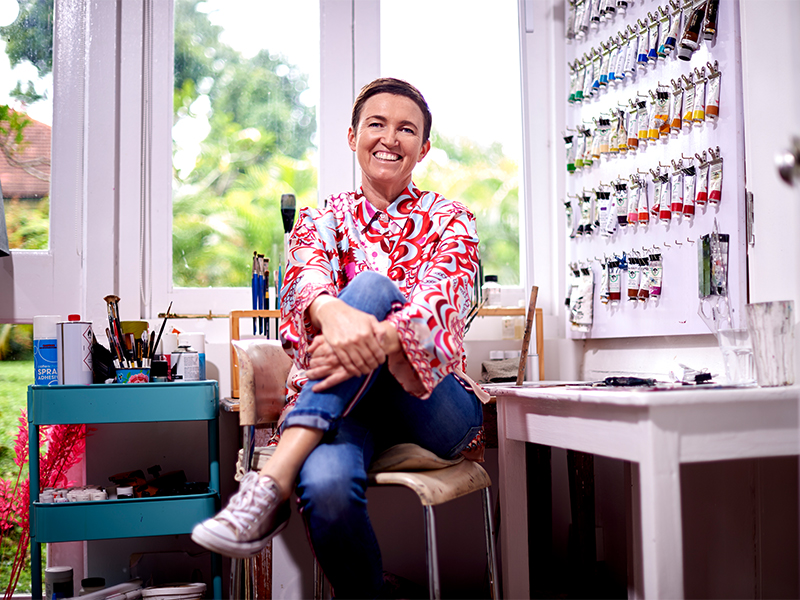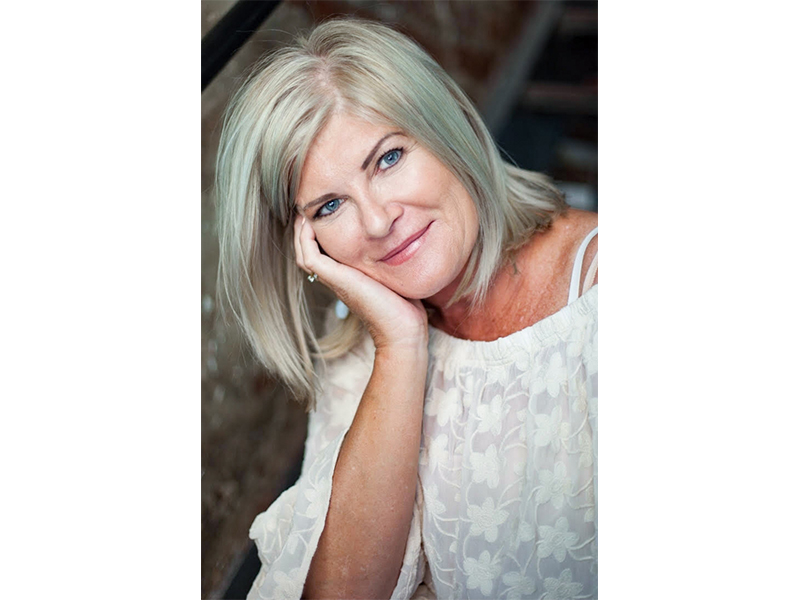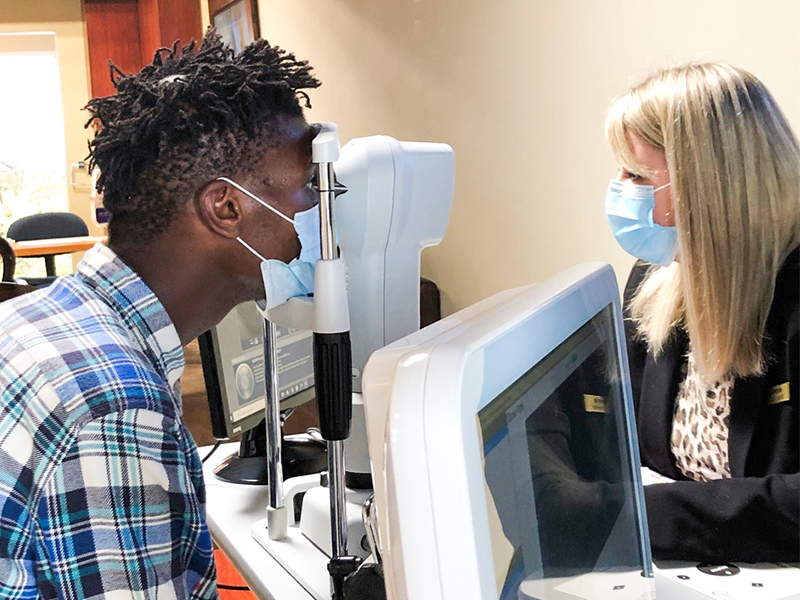Two South Africans – a former Singapore expat and a current one – are collaborating on a great cause in their home country.
After finishing a stint in Singapore in 2012, AMANDA SECCOMBE has gone on to launch a non-profit called the Eyes2Eyes Foundation, which aims to help people with treatable blindness in South Africa. Amanda was inspired to start the organisation after her own personal experience – and ongoing journey – with eye disease.
Artist SUE GRAY still lives in Singapore; she met Amanda here, and the two kept in touch in the years that followed. When Sue heard about Amanda’s challenges and the launch of Eyes2Eyes, she sought a way to get involved. She’s now selling fine art prints from her “Uprooted” series of paintings, and donating 100 percent of the proceeds to the foundation.

Amanda’s story
Tell us a bit about yourself and your time in Singapore.
I grew up on a farm in the Eastern Cape of South Africa, and ended up living in Cape Town most of my life. For years, I worked in marketing in the financial services industry, but eventually took a leap of faith into my great love of textiles and clothing, just before moving to Asia. Hong Kong was the first stop, but it was in Singapore that I started the brand White Ginger. I loved my time in Singapore, with frequent trips to Vietnam and Indonesia to source textiles and new designs. The expat community was great fun and leaving was bittersweet.

What did you do when you returned home?
I came back to South Africa in 2012 and started a new clothing and gifting company called Sunday Girl, which I still own and manage from Cape Town. When my eye problems started, I moved away from clothing production and added a bespoke florist service to the brand. It was a steep learning curve, but somehow flowers and foliage were more forgiving and therapeutic than trying to quality-control garment production with very limited sight! I’ve spent the last year back at university, completing a postgraduate degree in community eye health to improve my understanding of the landscape of eye care in the country.
Tell us about your personal background to the Eyes2Eyes Foundation.
In 2018, I lost my sight very suddenly in both eyes following a bacterial infection. Within a period of three weeks, my sight was completely gone. I went from being totally independent to living in the dark and eventually learning skills to live with severe low vision.
The condition was eventually diagnosed as acanathamoeba keratitis, resulting in my corneas being slowly and painfully eaten by living amoeba over a period of six months. My visual rehabilitation has taken almost three years to get to a point where I have functional vision for 10 hours a day – in one eye. The journey has been harrowing and humbling, and gave me huge insight into the challenges faced by our blind communities in South Africa. Eye care receives very little funding and support, so people end up living with avoidable and preventable blindness because of this.
I decided to try and do something to help others – and Eyes2Eyes was born. The name is based on the gift of sight from one eye to another through corneal donation. I was most fortunate to receive two donor corneas from America. Many people in South Africa don’t have that privilege, with cornea tissue being unavailable and the cost of transplants prohibitive. My vision still needs to be augmented with scleral lenses, and I hope to have my right eye fitted in early 2022.

What are some of the goals of Eyes2Eyes?
We have three main goals. The first is to purchase innovative new technology to facilitate screening of corneal disease; currently, there is only one microscope for this purpose in all of South Africa. Secondly, we’d like to fund two cornea transplants a month for public sector patients; currently, hundreds of patients are awaiting transplants in the Western Cape alone, with no cornea tissue available locally. Our third project is to provide customised scleral lenses to patients with cornea disease. These lenses are brought in from New Zealand – we don’t have the technology to make them locally and each one is designed to fit the contours of the diseased corneas of each patient so they get great vision and comfortable wear, without compromising their corneas further.
How common is corneal blindness?
Corneal blindness accounts for approximately 11 percent of blindness. This can be the result of trauma or disease, and more than 80 percent of cases can be treated effectively. Globally, the biggest cause of avoidable blindness is cataracts, with glaucoma and diabetic retinopathy accounting for around 20 percent of avoidable eye disease.
How did you come to collaborate with Sue on Eyes2Eyes?
I met Sue through the Africa Society while living in Singapore. We became good friends and shared a creative energy – and, of course, a great love for all things African! Sue generously hosted the launch of my clothing range White Ginger in her home and was always very encouraging and supportive.
We kept in touch over the years and she has been a great source of inspiration and encouragement as I navigated a new chapter, with very steep ups and downs. Naturally, when she contacted us to say she’d like to donate the proceeds from the sale of her “Uprooted” Series to Eyes2Eyes, we were overjoyed. Sue is an incredible artist, and an even more incredible human being, with a strong commitment to helping others and making a difference in the lives of people less fortunate in her home country.
What are your hopes for the organisation for 2022?
If I could wave a magic wand, I’d like to see a confocal microscope for ophthalmology available in the Western Cape. High-resolution imaging of the cornea will mean accurate screening and diagnosis, in place of invasive biopsies and often a process of elimination to arrive at a final diagnosis. We also have a target of helping 100 patients to get full visual rehabilitation next year. That’s really exciting. Seeing the joy on someone’s face when they go from only being able to detect hand movement to 20/20 vision is hard to put into words.
Personally, I’m really excited about using my new degree to make a big impact on eye care. I’m also looking forward to having the last sutures removed from my right eye and the final element of visual rehab completed for binocular vision next year!
A word from Sue
Tell us a bit about yourself and your expat “trail”. My family is originally from South Africa; we moved to Singapore 14 years ago. Initially, I focused on raising our three boys and I painted in my spare time; now that my kids are older I’m a full-time artist.
We still consider Cape Town to be “home” and even though my children have spent the majority of their lives in Singapore (my youngest son Sam was born here), we’re all very proudly South African. We have a holiday house about two hours out of Cape Town, and in pre-pandemic times we went home at least once a year.
My involvement with Eyes2Eyes came about largely as a result of feeling so helpless about the terrible poverty and suffering that was happening in South Africa; the pandemic made an already tough situation even worse. For some time, I’d been working on a series of paintings of uprooted aloes and succulents. I would often bring aloes back to Singapore from South Africa; I loved how they could continue to thrive in the tropics with their roots out of the ground. They became symbolic of my life as an expat. This series of paintings is created purely for giving back; all money raised from the selling of the originals and the fine art prints goes to South Africa.
By the way, we once featured your home in Expat Living – do you still live there?
Yes, you featured me in the first home we lived in in Singapore! It was a condo on Tanglin Road. We were only there for two years; after that, we moved to a house in Bukit Timah near the British Club. We were there for five years before moving to our current house – a black-and-white bungalow in Alexandra Park. I have a studio here, so I can work from home.
Describe your art for us.
I’m a self-taught, realistic still-life painter, and with my work I aim to capture the beauty of everyday objects. I bring these objects to life by painting them large and in a hyper-realistic style. I’m mostly known for my paintings of large scale, hyper-realistic bottles – I had a solo exhibition called “Bottles” at Art Porters Gallery in June last year; the response was so incredible that I’m currently working on a new series of Bottles for an upcoming show.

How did you come to know Amanda and collaborate with her?
We met years ago when she lived in Singapore – we were part of a large group of South African friends and we were also quite involved in the Africa Society of Singapore. We kept in touch when Amanda moved home and when I decided to create a series of paintings for charity and fundraising to help my fellow South Africans, the Eyes2Eyes Foundation was a perfect fit.
What are your hopes for the organisation for 2022?
Amanda has dedicated all her time and energy to making a meaningful and real difference in the lives of people living with reversible blindness in South Africa; my main goal is to try and help her raise funds, as the more money raised, the more people the foundation will help.
Find out more about Eyes2Eyes at eyes2eyes.org.za. Sue’s prints are available for purchase in South Africa through sundaygirl.co.za; for international orders, contact Sue at info@suegrayart.com or DM her through Instagram @suegrayart.
This article first appeared in the February 2022 edition of Expat Living. You can purchase the latest issue or subscribe, so you never miss a copy!
Don't miss out on the latest events, news and
competitions by signing up to our newsletter!
By signing up, you'll receive our weekly newsletter and offers which you can update or unsubscribe to anytime.
